ABOUT

IndiaSkis is proudly associated with the development of Luge Sport & markeing of its equipment in India.
Luge is the French word for sled, and historical findings point to the existence of sleds, as early as AD 800 with the Vikings in the Slagen countryside near the Oslo Fjord. The Vikings are believed to have had sleds with two runners, which resemble the modern-day version. The first international sled race occurred in 1883 in Davos, Switzerland, with 21 competitors from Australia, England, Germany, the Netherlands, Sweden, Switzerland and the United States. This race took place over 4km and was won by Georg Robertson, a student from Australia, and Peter Minsch, a mailman from Klosters. Both finished the race in just over nine minutes.
The first World Championships occurred on an artificial track in Oslo in 1955. Two years later, the International Luge Federation (FIL) was founded in Davos and remains the governing body of luge today. Luge made its Olympic debut at the 1964 Games.

COMPETITION
Singles
In men's and women's singles, athletes take four runs down the track. Each run counts. The four times are added, and the fastest total time determines the winner. The competition takes two days to complete (two runs per day). Men and women compete on the same track, but the women start from a position further down the course.
The four-run format is unique to the Olympic Winter Games and is designed to reward consistency, endurance and ability to withstand pressure, particularly on the second day. At most events, such as the World Championships and World Cup races, singles are contested over two runs.
Doubles
Doubles luge is a one-day competition in which pairs of athletes take two runs down a course. Each run counts. The fastest total time determines the winner. The two-run format also is used in World Championships and World Cup races. There is no rule that says a doubles team must comprise members of the same sex, but traditionally, men have ridden together, with the larger man lying on top for a more aerodynamic fit.
Equipments:
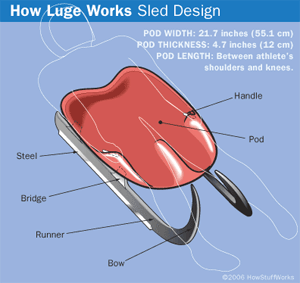 |
The sled is designed to maximize speed while allowing for precise control by the slider. |
For all the complexity of navigating a luge course, the equipment involved is pretty limited. There's a sled, a racing suit, gloves, boots and a helmet. Every piece of equipment in luge is designed for utmost aerodynamics, minimal friction and top speed.
A luge sled is a high-tech machine. It's made primarily of fiberglass and steel, and it's custom built for each athlete based on his or her height, weight and proportions. Luge teams contract companies to design and build their sleds based on custom specifications. Olympic slider Georg Hackl actually took his sled to the Porsche Engineering Group for some speed tweaks prior to the 2002 Olympics. But it's not just about design -- it's also about using the best materials. In 2004, the USA Luge Team called on US Steel to design a new type of steel for its sled runners in order to improve speed and performance.
The sled weighs between 50 and 60 pounds (23-27 kg) and runs from the slider's shoulders to his or her knees, and there is no head support.
The sled consists of:
- Two steels - The steels are the only part of the sled that contacts the ice. Steels are made of metal and are very sharp.
- Two bridges - The bridges are made of steel. They connect to the runners and support the pod.
- Two runners (sometimes called kufens, which is German for "runners") - Runners are usually made of fiberglass and are the main steering mechanism of the sled. The curved section (the bow) of each runner is flexible. Using their legs, sliders apply pressure to one or the other runner bow in order to steer through the course (they can also steer by making small movements with their shoulders to shift their weight).
1. Bridge
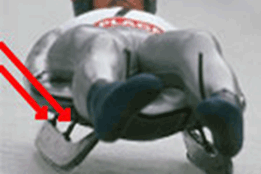
The part of a sled that connects the two runners and from which the aerodynamic racing shell is suspended. Made of steel, there are two bridges on each sled - one in front and one in back.
2.Gloves
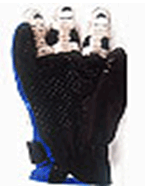
Luge gloves are spiked at the fingertips to assist with the start and paddling motion as the sliders accelerate onto the track.
3. Grip
Each hand holds a handle on the side of the sled.
4. Helmet
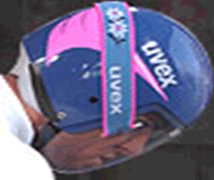
Sliders wear helmets that have a clear or tinted visor which extends under the chin to reduce resistance.
5. Kufen
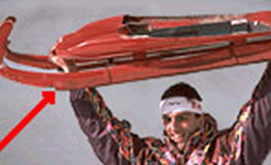
The German word for runner, usually made of fibreglass or wood. The slider steers by applying pressure with his/her foot onto the runners.
6. Pod
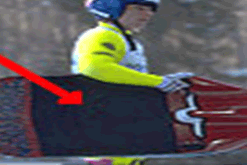
The aerodynamic shell which serves as the seat for the athlete.
7. Racing Suit
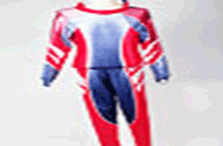
Sliders wear specially designed race suits to reduce wind resistance.
8. Shoes
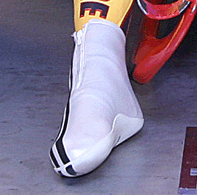
Sliders must wear special shoes with zipperss, so that the foot straightens out when the zipper is closed. There are also regulations for the insole and heel of the shoe.
9. Steel Runners or Steels

The sled rides along the track on two steel runners called steels. They are the only part of the sled that touches the ice's surface and are attached to the kufens.
Technical Terminology:
G-Force: Gravitational force that holds the sled and athlete on the wall of a banked curve. A "G" is equal to the force of gravity.
Kreisel: German word for circle; a curve that forms a circle by the track crossing over itself.
Labyrinth: A combination of small curves on a luge track with little or no straight stretches between them; a labyrinth usually consists of three to four curves.
Omega curve: From above, the curve resembles the Greek letter Omega.
Paddle: The action of accelerating the sled forward after the start, using spiked gloves to dig into the ice surface.
Slider: A luge athlete; rarely called a luger.
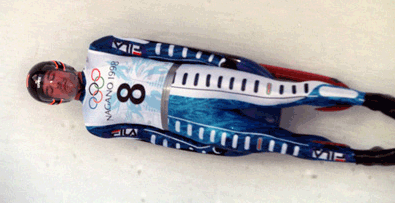
Olympic Rules
The basic rules of Olympic luge are pretty straightforward:
- Since weight is an advantage, male athletes must weigh at least 198 lbs (90 kg), and women must weigh at least 165 lbs (75 kg). This helps keep the playing field relatively even. Sliders weighing less than the minimum weight can attach extra weights to themselves to make up for the deficit.
- Singles sleds must weigh no more than 50.6 pounds (23 kg); doubles sleds cannot exceed 59.5 pounds (27 kg). Racing suits must weigh no more than 8.8 pounds (4 kg).
- Sleds cannot have any sort of mechanical brakes.
- Steels (the sled's blades -- the only part that touches the ice) cannot be heated. This would melt the ice during the run, decreasing friction between the steels and the ice to provide an unfair speed advantage. In 1968, the women's Olympic luge team from Germany was disqualified for heating the steels on their sleds.
|

